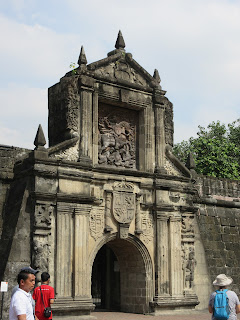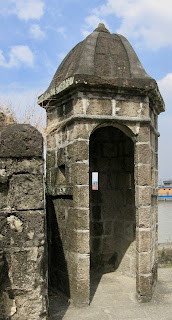 |
| Rizal Monument |
Best of Manila Highlights of this former Spanish colonial city. Rizal Park, named for the national hero Dr. Jose Rizal, whose writings ultimately led to Philippine independence. Rizal’s monument is point 0 for all roads in Philippines. Traveled through Old downtown Manila passing the Planetarium, the National Museum, Manila City Hall, Hones Bridge, the Philippino-Chinese Friendship Arch and the Binando, the local Chinatown and Old Intramuros, the Spanish Old Town that was home of the elite during the colonial era. This historic center was badly damaged during a WWII battle to take back the city from the Japanese. Visited San Agustin Church, the oldest stone church in the city. It was looted in 1762 by British, survived several earthquakes that leveled the city, has been a hospital and a concentration camp and also survived the 1945 American Japan conflict. Spent time in Casa Manila, a museum that chronicles life in colonial days. Explored Fort Santiago which has centuries-old ramparts and learned how Jose Rizal spent his last days as a prisoner within its walls.
 |
| San Agustin Church |
 |
| Fort Santiago |
 |
| See below. |
 |
| Walang Boots |
 |
Casa Manila, a museum that chronicles life in colonial days. |
 |
| Casa Manilla |
 |
| Manilla |
 |
| Monument is at the top of this post. |
 |
| Casa Manilla |
 |
| Casa Manilla |
 |
| Bamboo bike at Casa Manilla |
 |
| Memorial at Fort Santiago |
 |
| Thickness of the walls at Fort Santiago. |
 |
| Faces of Filipinos that died in the dungeons during the Japanese occupation are in each jar on the steps going down into the dungeons . |
 |
| Golf course outside the fort walls |
 |
| Fort Walls |





No comments:
Post a Comment